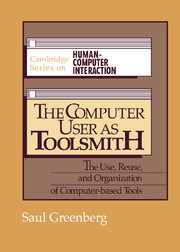Book contents
- Frontmatter
- Contents
- List of figures
- List of tables
- Foreword
- Acknowledgments and dedication
- 1 Introduction
- 2 Studying UNIX
- 3 Using commands in UNIX
- 4 Techniques for reusing activities
- 5 Recurrent systems
- 6 Reuse opportunities in UNIX csh – potential and actual
- 7 Principles, corroboration, and justification
- 8 Organizing activities through workspaces
- 9 A workspace system: description and issues
- 10 Conclusion
- Appendix A A sample trace
- Appendix B Summary statistics for each subject
- References
- Author index
- Subject index
7 - Principles, corroboration, and justification
Published online by Cambridge University Press: 26 May 2010
- Frontmatter
- Contents
- List of figures
- List of tables
- Foreword
- Acknowledgments and dedication
- 1 Introduction
- 2 Studying UNIX
- 3 Using commands in UNIX
- 4 Techniques for reusing activities
- 5 Recurrent systems
- 6 Reuse opportunities in UNIX csh – potential and actual
- 7 Principles, corroboration, and justification
- 8 Organizing activities through workspaces
- 9 A workspace system: description and issues
- 10 Conclusion
- Appendix A A sample trace
- Appendix B Summary statistics for each subject
- References
- Author index
- Subject index
Summary
The two preceding chapters analyzed command line recurrences with dialogs with the UNIX csh. Based on the empirical results, the first section of this chapter formulates general principles that characterize how users repeat their activities on computers. Some guidelines are also tabulated for designing a reuse facility that allows users to take advantage of their previous transaction history. The second section corroborates these principles by a post hoc study of user traces obtained from another quite different command line system. The final section steps back from the empirical findings and presents a broader view of reuse.
Principles and guidelines
This section abstracts empirical principles governing how people repeat their activities from the UNIX study described earlier. They are summarized and reformulated in Table 7.1 as empirically based general guidelines for the design of reuse facilities. Although there is no guarantee that these guidelines generalize to all recurrent systems, they do provide a more principled design approach than uninformed intuition.
Principles: how users repeat their activities
A substantial portion of each user's previous activities are repeated. In spite of the large number of options and arguments that could qualify a command, command lines in UNIX csh are repeated surprisingly often by all classes of users. On average, three out of every four command lines entered by the user have already appeared previously. UNIX is classified as a recurrent system by the definition in Section 5.1.
- Type
- Chapter
- Information
- The Computer User as ToolsmithThe Use, Reuse and Organization of Computer-Based Tools, pp. 108 - 122Publisher: Cambridge University PressPrint publication year: 1993

